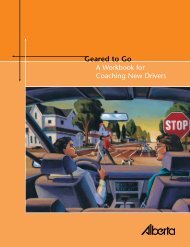Commercial driver's guide to operation, safety and licensing
Commercial driver's guide to operation, safety and licensing
Commercial driver's guide to operation, safety and licensing
You also want an ePaper? Increase the reach of your titles
YUMPU automatically turns print PDFs into web optimized ePapers that Google loves.
There are vehicle inspec<strong>to</strong>rs throughout<br />
the province who conduct commercial<br />
vehicle inspections. Vehicles that do not<br />
meet the requirements can be taken<br />
out-of-service until the repairs are made.<br />
This can also result in fines <strong>and</strong> points<br />
assessed on the Carrier Profile or the<br />
driver’s <strong>Commercial</strong> Driver Abstract.<br />
Trip inspection<br />
schedule<br />
Application of inspection<br />
schedule<br />
• A truck, a trac<strong>to</strong>r <strong>and</strong> <strong>to</strong>wed trailer<br />
are inspected using Schedule 1. A<br />
converter dolly is inspected as part of<br />
the trailer it is carrying. The dolly is <strong>to</strong><br />
be inspected again when carrying a<br />
different trailer.<br />
• Carriers are required <strong>to</strong> supply drivers<br />
with a copy of the inspection schedule.<br />
• Drivers are required <strong>to</strong> carry <strong>and</strong><br />
produce the inspection schedule<br />
<strong>to</strong> an officer.<br />
• A schedule <strong>and</strong> an inspection report<br />
may be combined on the same<br />
document.<br />
Where <strong>to</strong> get inspection<br />
schedules<br />
Schedule 1 - 4 of National Safety Code<br />
St<strong>and</strong>ard 13, which is published by<br />
the Canadian Council of Transport<br />
Administra<strong>to</strong>rs (CCMTA), is acceptable in<br />
Alberta, including when produced by the<br />
driver of an Alberta plated commercial<br />
vehicle. These schedules may be viewed<br />
at: www.ccmta.ca. Some companies,<br />
associations <strong>and</strong> organizations also<br />
produce <strong>and</strong> sell schedules <strong>and</strong><br />
report forms.<br />
Trip inspections<br />
Inspection procedures<br />
Note: Only the driver is referenced as<br />
the inspection person throughout the<br />
remainder of this chapter.<br />
Drivers may choose an inspection<br />
procedure (circle procedure) that<br />
best suits the vehicle <strong>and</strong> its location.<br />
However, whichever procedure is used,<br />
each regulated inspection item must<br />
be inspected <strong>and</strong> where a defect is<br />
discovered the defect must be recorded<br />
on the report <strong>and</strong> reported <strong>to</strong> the carrier.<br />
The following detailed trip inspection<br />
is for reference only. Check with your<br />
employer <strong>to</strong> determine if the company<br />
has its own forms for recording vehicle<br />
condition.<br />
Note: A vehicle trip inspection is required<br />
as part of the road test when applying for<br />
a Class 1, 2 <strong>and</strong> 3 opera<strong>to</strong>r’s licence.<br />
Before beginning the<br />
inspection<br />
Choose terrain that is as level as<br />
possible <strong>and</strong> park the vehicle safely<br />
away from traffic.<br />
Set parking/spring brake. Place the<br />
transmission in low gear for a<br />
manual transmission.<br />
Shut off the engine.<br />
28 A <strong>Commercial</strong> Driver’s Guide <strong>to</strong> Operation, Safety <strong>and</strong> Licensing




